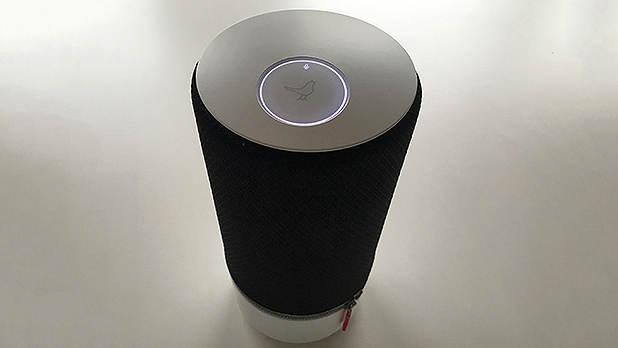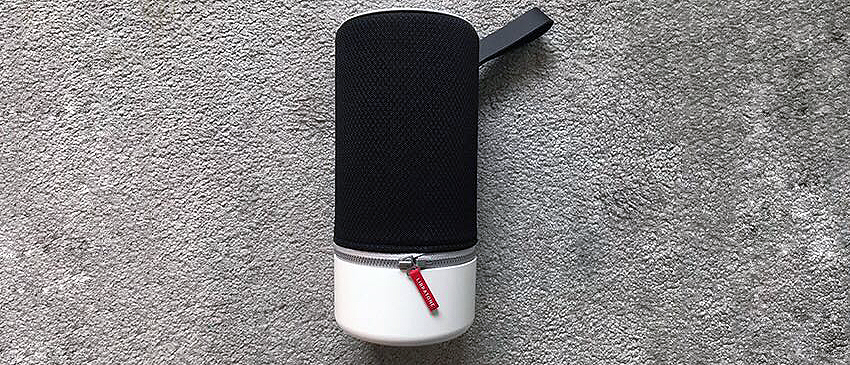TechRadar Verdict
Bringing proper support for Alexa and AirPlay 2, this update to the Scandinavian designed cylinder speaker makes it the smartest speaker for both looks and features.
Pros
- +
Built-in battery
- +
Wealth of connectivity options
- +
Full-bodied sound
Cons
- -
Pricey
- -
No support for Google Assistant
- -
App can be buggy
Why you can trust TechRadar
In a world of increasingly identikit smart speakers, Libratone’s previous version of its Zipp portable wireless speaker cut a very different look to the competition when it was launched a few years back.
Wearing a cheerful fabric cover finished off with a somewhat eccentric zip and a leather loop for hanging the device, the part Danish, part Chinese firm’s tubular speaker boasted a built-in battery as well as mains power, plus a wealth of connectivity and streaming options that placed it ahead of much of the opposition.
This latest version retains the offbeat looks of its predecessor, but brings an improved array of built-in microphones for proper Alexa voice assistant support this time round. There’s also a boosted battery and an overhaul of its 360-degree ‘FullRoom’ sound.
At £279, its pricey compared to other portable speakers. This works out at around $365 / AU$510, however there's no word on when it will be available in the US and Australia.
Beyond the WiFi and Bluetooth smarts that we’ve come to expect from any connected speaker, there’s also Spotify Connect, easy access to Tidal and TuneIn Radio, plus DNLA support for network steaming. Alongside this, a recent firmware update has brought full Apple Airplay 2 multi-room support - a significant development insofar as it makes the Zipp 2 the only Airplay 2 supporting speaker that can currently be used mains-free.
Beyond this, there’s also Libratone’s own Soundspace Link multi-room tech, allowing you to group up a stereo pair of Zipp 2’s or up to 10 Zipp speakers together over WiFi in one space, or over multiple different rooms.

Design
As with the previous iteration, the Zipp 2’s cylindrical frame has a snug fitting, diamond-patterned sleeve made from a semi-glossy threaded material. While stylish, its coat isn’t waterproof, limiting its outdoor use when compared to the similarly sized Ultimate Ears Megaboom. Nevertheless, the Zipp 2 is at least humidity-resistant, meaning its still an option for bathroom singalongs and steamy kitchens.
Sign up for breaking news, reviews, opinion, top tech deals, and more.
The speaker comes in four different color options from the get go (red, green, black and grey), but if those don’t match your décor, the jacket unzips, and can be removed and swapped for several other color options. Good luck for anyone looking to make the change though. Much like an non-compliant child ahead of a morning school run, getting its jacket on is a somewhat infuriating struggle if you want the material taut and crease free.
Should you brave taking its coat off, you’ll be able to peer inside the Zipp 2’s cylindrical frame, where you’ll find a 1inch tweeter and two 4inch passive radiators along with a 4inch neodymium woofer that all work alongside a reflector to spread the output in all directions.
Features and performance
Setup is relatively straight forward, and is handled via Libratone’s well-designed corresponding app for iOS and Android. From here you can link up your Amazon account for Alexa, add your details for streaming sources like Spotify and Tidal, as well as set up a favorites list (more on that later).
The app also contains a wide range of EQ tweaking options, with a number of 'voice' presets to suit musical genres and spoken content, along with five settings that are tuned for where the device is positioned (shelf, table, floor, outside and neutral).
EQ presets such as these all too often feel like an afterthought with many devices, but Libratone appears to have actually taken into account the makeup and layout of the Zipp 2’s speaker placement as they make a meaningful difference to the sound space.
Things improve further when using the speaker’s built-in room correction feature. When engaged, the speaker scans its surroundings for reflections to create an enhanced sound tailored for its location. It’s a feature that’s barely touched upon in the Zipp 2’s manual, yet it makes a profound, positive difference to how the device sounds.
On the top of the speaker is the Zipp 2’s neat, disc-like touch interface, which on the whole works well, albeit with a few quirks. A quick touch of the Libratone logo on the top of the device brings up a lit ring of options, including microphone on/off, WiFi connection, the aforementioned room correction and favorites, plus Soundspace Link and firmware update.
Running your finger up and down the rim of the circular control area adjusts the volume, while tapping the bird emblem plays and pauses music or answers & end phone calls (fact fans: the Libratone logo is a nod to Denmark’s most famous storyteller Hans Christian Andersen and his story of the Nightingale, symbolizing how the company aims “to set music free”). You can also handily lower the volume momentarily placing your hand over the top of the speaker.

While the previous Zipp speaker was given access to Alexa in a post-release update, the feature on previous models could only be engaged by holding down the microphone button on the top of the device. This time around there’s an array of six far field mics, allowing you to give voice commands hands-free from across the other side of the room.
During testing the Zipp 2 had no problem picking up our commands at the opposite end of a large, 8 x 6 meter room with a TV on at high volume and was also impressively able to pick up our voice from parts of the room next door.
For those that don’t fully trust Amazon’s privacy policies, the mic on/off button allows the built-in microphone array to be switched off, letting you control what the speaker does and doesn’t hear - a pertinent feature as concerns grow over how personal data is used and one we’d like to see on more smart speakers.
The one glaring omission from the Zipp 2’s spec sheet at this point is the lack of support for Google Assistant. Libratone’s current official line is that its something they’re seriously considering adding at a later date, so fingers crossed it’ll be part of a future update.

As mentioned earlier, the Zipp 2 can store five 'favorites' on the device that can be called up quickly via the app, or the speaker‘s touch interface. The favorites can be set up through the app and can be anything from a radio station, playlist, album or even a single track.
While certainly a welcome feature, it proved to be the one time we ran into problems with the touch interface. Playing a particular favorite from the device’s control panel requires you to tap the corresponding button a number of times in accordance to its preset number - so to play preset five, for example, you need to quickly press the button five times.
There’s something of a knack to this, as more often than not, some of our button presses would often not be registered by the device, resulting in the wrong favorite being played.
A similar irritation comes with the app, which seems to get confused when playing something gets played via the app and then something different is then chosen to be played via the speaker’s built-in controls and vice versa. Switching between selection methods will often result in the app showing the wrong information for what’s playing – a minor issue granted, but an annoying one that we’d like to see fixed in any upcoming software update.
As with its predecessor, there’s a USB port at the bottom of the speaker allowing you to plug in a thumb stick or hard drive and play the music stored on it, with the touch controls at the top of the speaker used to move through the files in the order they were placed on the drive. It’s obviously a nice option to have but with the host of streaming options available, in particular DLNA, its a bonus that feels somewhat inessential.

For this review we were only provided a single Zipp 2, so we weren’t able to try out Soundspace Link – Libratone’s own system for multi-room sound when using its speakers. Early owners appear to have run into problems in trying to stream tracks directly from devices over Bluetooth when a speaker was set up in this manner, but this issue appears to have been resolved by a firmware update released by Libratone towards the end of our testing.
For all its offbeat jacket design and Alexa smarts, the Zipp 2’s key selling point for many at this time will be is its mains-free capabilities. There’s a scant number of quality wireless speakers with a built-in battery right now, and none with this sort of output or connectivity.
We managed to get an impressive 11 hours of streamed internet radio at medium volume before the Zipp 2’s battery eventually conked out. While a quick tap of the speaker’s control area will reveal remaining battery life, as does the app, if you’re out of the line of sight of either you may find you’re music coming to an abrupt end as the speaker only audibly notifies you its running out of juice just a few seconds before it shuts down.
Final verdict
To our ears at least, rival device’s like the Sonos Play:1 and Apple’s HomePod beat the Zipp 2 for overall fidelity and definition, with the latter’s take on 360-degree sound representing a step up in terms of delivering a broader sweet spot, but overall there isn’t a big gulf in performance.
It manages to gets up an to impressively uncomfortable output level at full blast without a hint of distortion, but maybe just lacks a little mid and low range definition to make it the best in its class.
The Danish design philosophy of less is more, doesn’t quite apply to the Zipp 2 with a connectivity list that’ll make most other smart speakers envious. This makes it almost platform-agnostic, allowing it to handily fit into a lot of existing multi-room arrangements (folks using AirPlay 2 enabled Sonos systems or Apple AirPods look most likely to benefit here).
Take this into consideration, along with the flexibility its battery brings and its all-round satisfying sound, and you have the smartest multi-room speaker currently out there.

Kevin Lynch is a London-born, Dublin-based writer and journalist. The author of Steve Jobs: A Biographic Portrait, Kevin is a regular feature writer for a number of tech sites and the former Technology Editor for the Daily Mirror. He has also served as editor of GuinnessWorldRecords.com and has been a member of the judging panel for the BAFTA British Academy Video Game Awards. Alongside reviewing the latest AV gear, smartphones and computers, Kevin also specialises in music tech and can often be found putting the latest DAWs, MIDI controllers and guitar modellers through their paces. Born within the sound of Bow Bells, Kevin is also a lifelong West Ham fan for his troubles.
